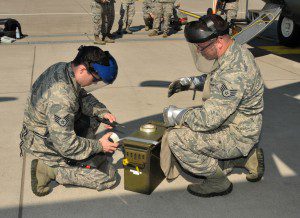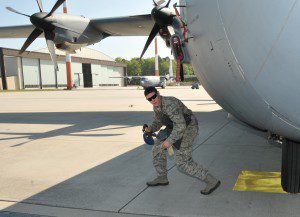
The non-commissioned officer in charge of operations, 104th Explosive Ordnance Disposal Flight, Barnes Air National Guard Base, Westfield, removes flares from a C-130 aircraft May 13, at Ramstein Air Base, Germany. This was part of an EOD exercise and fulfilled their yearly aircraft-training requirement. (U.S. Air National Guard photo by 2nd Lt. Bonnie Harper/Released)
by Tech. Sgt. MELANIE J. CASINEAU
104th Fighter Wing
RAMSTEIN AIR BASE, Germany — Two Airmen from the 104th Explosive Ordnance Flight (EOD), 104th Fighter Wing, Barnes Air National Guard Base, trained on a C-130 aircraft for an emergency response exercise May 13 at Ramstein Air Base, Germany.
The aircraft training that the two Airmen participated in covered one of the five major foci that the Airmen have to train on every year for EOD: weapons of mass destruction, chemical biological agent, improvised explosive device, conventional munitions, and aircraft.

The non-commissioned officer in charge of equipment, 104th Explosive Ordnance Flight (EOD), 104th Fighter Wing, Barnes Air National Guard Base, Westfield, walks around the C-130 aircraft prior to “safeing” it, May 13, Ramstein, Air Base Germany. He is an emergency responder who will be qualified on “safeing” the C-130 aircraft, making him more valuable to the 104th Fighter Wing and New England area. (U.S. Air National Guard photo by Tech. Sgt. Melanie J. Casineau/Released)
“At the 104th, I train on the F-15 aircraft. This is my fist time training on a C-130 aircraft,” said non-commissioned officer in charge of operations, 104th EOD. “This is important training because we are emergency responders and are now able to respond to any emergencies involving C-130s in New England.”
“If Quansett, Rhode Island, a C-130 wing, is deployed and cannot take care of the aircraft, we are now qualified to do it for them,” he said, for example.
The training that was done on the C-130 aircraft is called “safeing,” taking a system that is armed and de-arming it, making it safe, he said. EOD must eliminate all possible explosives.
“The three reasons we would ‘safe’ an aircraft are an accident, mishap, or crash,” he said.
In an emergency situation in the states, the fire department would be the primary response for egress if the pilot is unable to do it, but EOD must be trained and capable of responding as a backup.
If there is no fire department on base or it is an international fire department, then EOD would provide the primary response. Overseas there is a higher likelihood that the fire department on base is not familiar with American aircrafts, he said.
“I was overseas on a base that only had Polish aircraft and only a Polish fire department,” he said. “When an American aircraft had an emergency landing on their flight line, they were not familiar with the procedures to shut it down. The only people who were familiar with the aircraft besides the pilot were us (EOD).”
The Airmen are now more qualified than they were before this deployment and more valuable to their unit and the units around them. Additionally, they are better trained and prepared for their next deployment alongside their active-duty counterparts.


